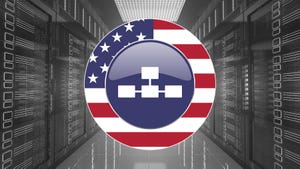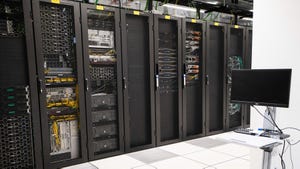Energy Industry Ramps Up Efforts to Solve the Data Center Power ShortageEnergy Industry Ramps Up Efforts to Solve the Data Center Power Shortage
At the Baker Hughes Annual Meeting in Italy, energy leaders discussed the growing power demands of AI data centers and their impact on infrastructure.
February 10, 2025

This year’s Baker Hughes Annual Meeting in Florence, Italy, highlighted just how far interest in data centers has expanded beyond the IT sector. A large crowd of delegates from the energy sector gathered for a breakout session on data centers last week, where the discussion centered on the strain generative AI is placing on power infrastructure.
The scene was set with a Goldman Sachs projection that data center power demand will grow by 165% by 2030 – raising concerns about whether local grids can keep pace without compromising reliability.
Panelists from the data center, government, and energy sectors chimed in with their opinions, offering insights into the challenges and potential solutions for balancing AI-driven demand with grid stability.
“The data center market was growing steadily due to the cloud and has been supercharged by AI,” said Jeffrey Tapley, COO of data center owner-operator Digital Realty. “Three years ago, we had an oversupply of data centers, but AI is now pushing up price rates for data center space, which is doubling in some markets.”
Tapley explained that transmission and power constraints exist in many municipalities. He noted that grid connections for new data centers are often delayed by a year or more, even after initial assurances of power availability.
“I don’t find comfort in being told that I’ll have power for a new data center by 2030,” said Tapley. “We prefer to look at how we can get power to the site ourselves.”

Panelists at the 2025 Baker Hughes Annual Meeting discussed the mounting power demands of AI-driven data centers (Photo credit: Drew Robb)
Location, Location, Location
Hyperscalers are demanding massive power near AI development hubs, where large language models (LLMs) are trained in data centers. Since the ‘learning phase’ of AI isn’t latency-sensitive, proximity to end users isn’t a priority. Even so, Tapley said he was hesitant to build data centers solely dedicated to these workloads.
“If you colocate a data center for AI, that site might not be needed in seven years,” he said. “On the other hand, metro areas will always need more power for the ever-expanding cloud, even if AI doesn’t take off as expected. Digital Realty, then, is focused on expanding its metro area footprint as it expects that sector to continue to be strong.”
Tapley wasn’t especially keen on renewables or battery storage either. He said they take up too much land – valuable real estate that Digital Realty prefers to prioritize for its data center halls.

The data center breakout session attracted a packed audience (Photo credit: Drew Robb)
Another key factor in data center site selection is proximity to the natural gas network. Tapley noted that gas power is a more viable option for facilities located near existing pipelines, making it easier to justify investment in onsite generation.
However, extending gas infrastructure to more remote data centers can require years of negotiations over easements and significant costs. For example, while one company recently built a modular data center in Virginia with a gas pipeline at its doorstep, Digital Realty’s new site near Dulles Airport faces a different challenge – the nearest gas line is at least six miles away.
Extending a gas pipeline to the facility would require substantial investment, so Digital Realty plans to diversify its power sources as the project scales. Whether gas generation will ultimately play a role remains uncertain.
“We could spend a lot of money on the pipeline, and then demand might go away,” Tapley said.
Onsite Efficiency for Tomorrow’s Data Centers
Jonathan Maxwell, founding partner and CEO of Sustainable Development Capital LLP (SDCL), highlighted systemic energy inefficiencies and stressed the need for onsite solutions. SDCL, which has $2.5 billion invested in onsite energy for industry and transport, has significantly increased its focus on data centers.
“The dirty little secret is that most energy is wasted: 8% in extracting and converting it, 50% in heat losses, and 5-10% at the point of use,” said Maxwell. “By the time data center operators pay for expensive power, most of it wasted.”
The way to solve this issue, he argued, is by building energy solutions where they are most needed – onsite. In the past, 25% of SDCL’s business has been in data centers. It has now ramped up to 50-60% of current projects.
“If you can generate energy locally, it is usually cheaper than the grid,” said Maxwell.
The CEO sees batteries playing an increasingly important role as data centers gradually phase out diesel generators for backup power. After all, batteries are a familiar technology courtesy of uninterruptible power supply (UPS) systems. Natural gas is another option that could be used to replace diesel, he added.
Maxwell recommended a review of ‘cogeneration’ options such as the use of waste heat to provide steam for heating and cooling. This is a good way to improve project economics.
Greg Joiner, executive vice president of renewable power generation at Shell Energy, concurred.
“We need more batteries and gas peaking units to smooth out demand,” he said. “Hybrid solutions give the balance of affordability, sustainability, and security.”
U.S. Infrastructure Constraints
The final panelist at this year’s Baker Hughes session was Dan Brouillette, U.S. energy secretary during President Trump’s first term. He continued the theme of infrastructure constraints impacting the high-growth tech space. Despite the new president’s recurring “Drill, baby, drill,” mantra, significant hurdles stand in the way of utilizing the abundant energy resources of North America. The region’s huge oil and gas reserves are hard to transport to key internal markets and to the coast for export.
“We need better pipelines and many more of them to be able to move gas to the ocean,” said Brouillette.
Grid-wise, he cited forecasts that the U.S. would be close to 30 GW short of capacity in the next five years. That was before the ongoing surge in data center demand. Waiting around for power and gas lines is not an option for those hoping to capitalize on AI.
“Colocation will be more and more the future,” said Brouillette. “Bring your own power is going to be a major trend.”
Like Tapley, Brouillette doesn’t see renewables as an immediate answer to AI power demands. Land use needs and a capacity factor of around 30% will limit the role of renewables in AI data centers. Similarly, nuclear development will take too long.
The federal government may be easing regulations and accelerating the permitting process for infrastructure, but there will still be plenty of state and local approvals to be earned. And then there is the specter of litigation hovering over data center expansion.
“Permitting reform might need to be supported by legal reform,” said Brouillette.
DeepSeek Disruption
Amid discussions of AI's surging power needs, a new development out of China – DeepSeek AI – promises to significantly cut energy consumption. But will it change the long-term outlook?
Shortly before the conference, China unveiled DeepSeek AI with the promise of lowering AI power demands by more than 90%. Brouillette believes the open source technology will have an immediate impact but is unlikely to alter long-term energy demand. While advances like DeepSeek may temporarily delay projections of data center energy spikes, Brouillette argues that AI’s long-term power demands will remain vast.
“Even if DeepSeek’s energy promises are proved out, it will impact the timeline of energy predictions but not the amount,” said Brouillette.
Read more about:
EuropeAbout the Author
You May Also Like









